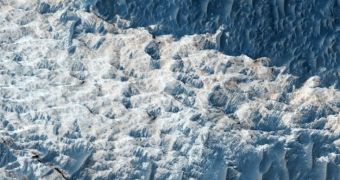Recent observations by the Mars Reconnaissance Orbiter (MRO), in orbit around the Red Planet, reveal new insight into Terra Meridiani, or Sinus Meridiani. The albedo feature stretches from East to West, just beneath the equator, and was given its name by French astronomer Camille Flammarion, as far back as the late 1870s. The “Sinus” part of the name was dropped once orbiters started flying around Mars in the 1960s, in favor of “Terra.” This allowed experts to more accurately name the feature, based on its actual topography. Now, MRO shows new details about the formation, Space Fellowship reports.
Using the onboard High Resolution Imaging Science Experiment (HiRISE) camera, the orbiter was able to snap a photo of a part of the albedo feature. Also included in it is Meridiani Planum, or the Meridiani Plane, which is the landing site of the MER robot Opportunity. The new image catches a patch of land that is about 500 kilometers (310 miles) to the East-Northeast of the rover's landing site. Dark sands covering bright bedrock are featured in the photograph, which experts are currently analyzing in more detail.
According to experts managing the HiRISE instrument, there are three types of terrains featured in the new photo. In the upper part of the image, the spacing of the dark ridges seems to indicate that the structures were formed by wind deposition. The large ripples and dunes that form are most likely made of sand, geologists and planetary scientists say. Extrapolating from data collected by Opportunity at more distant sites, the group concludes that the sand is of a basaltic composition. This means that it is very different from its counterpart on Earth, which is mostly based on mineral quartz.
“The basaltic sand here and elsewhere on Mars probably formed from the breakup of volcanic rock via water, wind, impact, volcanic, and maybe other processes. It was then sorted and organized into dunes and ripples by the wind. Two expanses of relatively sand-free terrain are seen in the upper part of the image. The gray material at upper center has a polygonal pattern when viewed at high resolution. The polygons may be fracture (jointing) patterns induced by local stresses in the rock or possibly from desiccation (drying) of the original material that formed the gray unit,” Nathan Bridges writes on HiRISE's website.
“The third terrain is a bright rocky unit at top center of uncertain origin. It is at the base of a cliff, above which is the gray unit. Therefore, the bright material may be older than the gray polygonal unit. Because both units are exposed today, they must have been partially uncovered in the past, with sand recently covering them again in some areas,” he concludes.
The orbiter has just recently been taken out of safe mode, after having suffered another glitch in 2009. Last year saw the spacecraft's computers break down four times, which caused a lot of stir at the NASA Jet Propulsion Laboratory (JPL), which manages the mission. Since MRO started surveying the Red Planet, back in 2006, its six science instruments have collected more data about the atmosphere and surface of Mars than all present and past missions combined.

 14 DAY TRIAL //
14 DAY TRIAL //